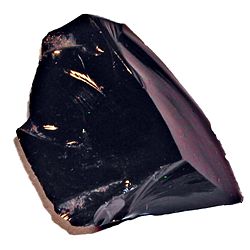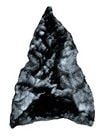Difference between revisions of "Obsidian" - New World Encyclopedia
(imported latest version of article from Wikipedia) |
(added credit and category tags, deleted foreign language links) |
||
| Line 2: | Line 2: | ||
[[image:ObsidianOregon.jpg|right|thumb|250px|Obsidian from Lake County, Oregon]] | [[image:ObsidianOregon.jpg|right|thumb|250px|Obsidian from Lake County, Oregon]] | ||
[[image:Different_rocks_at_Panum_Crater-750px.jpg|right|thumb|250px|Counterclockwise from top: '''obsidian''', [[pumice]] and [[rhyolite]] (light color)]] | [[image:Different_rocks_at_Panum_Crater-750px.jpg|right|thumb|250px|Counterclockwise from top: '''obsidian''', [[pumice]] and [[rhyolite]] (light color)]] | ||
| + | |||
'''Obsidian''' is a rock which is a type of naturally occurring [[glass]], produced by [[volcano]]es ([[igneous]] origin) when a [[felsic]] [[lava]] cools rapidly and freezes without sufficient time for crystal growth (see [[glass transition temperature]]). Obsidian is an extrusive igneous rock. It is commonly found within the margins of felsic lava flows, where cooling is more rapid. Because of the lack of crystal structure, obsidian blade edges can reach almost molecular thinness, leading to its ancient use as [[arrow]]heads, and its modern use as surgical [[scalpel]] blades. | '''Obsidian''' is a rock which is a type of naturally occurring [[glass]], produced by [[volcano]]es ([[igneous]] origin) when a [[felsic]] [[lava]] cools rapidly and freezes without sufficient time for crystal growth (see [[glass transition temperature]]). Obsidian is an extrusive igneous rock. It is commonly found within the margins of felsic lava flows, where cooling is more rapid. Because of the lack of crystal structure, obsidian blade edges can reach almost molecular thinness, leading to its ancient use as [[arrow]]heads, and its modern use as surgical [[scalpel]] blades. | ||
| Line 38: | Line 39: | ||
*[http://mineral.galleries.com/minerals/mineralo/obsidian/obsidian.htm Obsidian: Mineral galleries] | *[http://mineral.galleries.com/minerals/mineralo/obsidian/obsidian.htm Obsidian: Mineral galleries] | ||
*Carlos Mordo, Easter Island (Willowdale, Ontario: Firefly Books Ltd., 2002) 109 | *Carlos Mordo, Easter Island (Willowdale, Ontario: Firefly Books Ltd., 2002) 109 | ||
| − | |||
| − | |||
| − | |||
| − | [[ | + | [[Category:Physical sciences]] |
| − | [[ | + | [[Category:Earth sciences]] |
| − | [[ | + | [[Category:Geology]] |
| − | + | ||
| − | + | {{credit|121845687}} | |
| − | |||
| − | |||
| − | |||
| − | |||
| − | |||
| − | |||
| − | |||
| − | |||
| − | |||
| − | |||
| − | |||
| − | |||
| − | |||
| − | |||
| − | |||
| − | |||
| − | |||
| − | |||
Revision as of 17:32, 11 April 2007
- This article is about volcanic glass. For other uses see obsidian (disambiguation).
Obsidian is a rock which is a type of naturally occurring glass, produced by volcanoes (igneous origin) when a felsic lava cools rapidly and freezes without sufficient time for crystal growth (see glass transition temperature). Obsidian is an extrusive igneous rock. It is commonly found within the margins of felsic lava flows, where cooling is more rapid. Because of the lack of crystal structure, obsidian blade edges can reach almost molecular thinness, leading to its ancient use as arrowheads, and its modern use as surgical scalpel blades.
Origin and properties
While a rock like basalt is dark because of ferromagnesian enrichment, obsidian consists mainly of SiO2 (silicon dioxide), usually 70% or more. Obsidian is mineral-like, but not a true mineral because it is not crystalline. Its composition is very similar to that of granite and rhyolite. It is sometimes classified as a mineraloid. Because obsidian is metastable at the earth's surface (over time the glass becomes fine-grained mineral crystals), no obsidian has been found that is older than Cretaceous age. The breakdown of obsidian is accelerated by the presence of water. Tektites were once thought by many to be obsidian produced by lunar volcanic eruptions, though few scientists now adhere to this hypothesis.
While pure obsidian is usually dark in appearance, the color varies depending on the presence of impurities. Iron and magnesium typically give the obsidian a dark green to brown to black color. A very few samples are nearly clear. In some stones, the inclusion of small, white, radially clustered crystals of cristobalite in the black glass produce a blotchy or snowflake pattern (snowflake obsidian). It may contain patterns of gas bubbles remaining from the lava flow, aligned along layers created as the molten rock was flowing before being cooled. These bubbles can produce interesting effects such as a golden (sheen obsidian) or rainbow sheen (rainbow obsidian). Obsidian is relatively soft with a typical hardness of 5 to 5.5. Its relative density is approximately 2.6.
Among other places, Yellowstone National Park has a mountainside containing much obsidian (located between Mammoth Hot Springs and the Norris Geyser Basin). It can also be found in Scotland.
Historical use
Obsidian was highly valued in certain Stone Age cultures because, like flint, it could be fractured to produce sharp blades or arrowheads. Like all glass and some other types of naturally occurring rocks, obsidian breaks with a characteristic conchoidal fracture. It was also polished to create early mirrors.
Pre-Columbian Mesoamericans' use of obsidian was extensive and sophisticated, including carved and worked obsidian for tools and decorative objects (see Obsidian use in Mesoamerica). The ancient Mesoamericans also made a type of sword with obsidian blades mounted in a wooden body. Called a macuahuitl, the weapon was capable of inflicting terrible injuries, combining the sharp cutting edge of an obsidian blade with the ragged cut of a serrated weapon that brought fear.
Native Americans traded obsidian throughout North America. Each volcano and in some cases each volcanic eruption produces a distinguishable type of obsidian, making it possible for archeologists to trace the origins of a particular artifact.
Obsidian was also used in the construction of the Moai (the large stone statues on Easter Island).
Current use
Obsidian is used in cardiac surgery, as well-crafted obsidian blades have a cutting edge up to five times sharper than high-quality steel surgical scalpels, with the edge of the blade reaching veritable molecular thinness. It produces a cleaner cut and less tissue trauma, which translates to faster healing and less scar tissue[1].
Obsidian is also used for ornamental purposes and as a gemstone, for it possesses the peculiar property of presenting a different appearance according to the manner in which it is cut. When cut in one direction it is a beautiful jet black; when cut across another direction it is glistening gray. "Apache tears" are small rounded obsidian nuggets embedded within a greyish-white perlite matrix.
See also
- Obsidian use in Mesoamerica
- Hyaloclastite, tachylite - volcanic glasses with basaltic composition
- Flint knapping
ReferencesISBN links support NWE through referral fees
- USGS Obsidian photo glossary
- Jim Miller, Obsidian is Hot Stuff, Volcano World
- Obsidian: Mineral galleries
- Carlos Mordo, Easter Island (Willowdale, Ontario: Firefly Books Ltd., 2002) 109
Credits
New World Encyclopedia writers and editors rewrote and completed the Wikipedia article in accordance with New World Encyclopedia standards. This article abides by terms of the Creative Commons CC-by-sa 3.0 License (CC-by-sa), which may be used and disseminated with proper attribution. Credit is due under the terms of this license that can reference both the New World Encyclopedia contributors and the selfless volunteer contributors of the Wikimedia Foundation. To cite this article click here for a list of acceptable citing formats.The history of earlier contributions by wikipedians is accessible to researchers here:
The history of this article since it was imported to New World Encyclopedia:
Note: Some restrictions may apply to use of individual images which are separately licensed.



